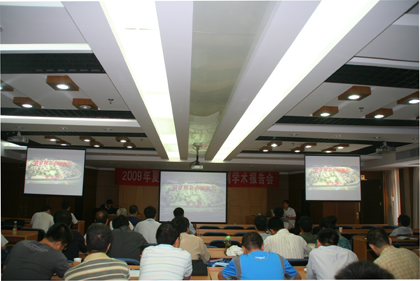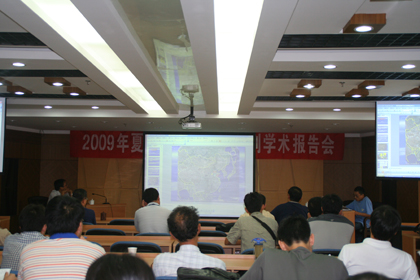The Summer 2009 Research and Young Scholars Forums Held at the Institute of Archaeology
The Summer 2009 Research and Young Scholars forums were held in the meeting room on the 8th floor of the Institute of Archaeology CASS on July 21, 2009. Details of the day's events are listed below :
The Summer 2009 Research Forum was opened at 9am and was presided over by Director Wang Wei.
The first speaker was Zhu Yanping, whose presentation was titled "A Study of South Korea's Neolithic Relics". Zhu gave an account of the Neolithic sites he had visited and studied during his visit to South Korea and, in doing so, he was able to cast light on the questions surrounding the cultural sequence of South Korea's Neolithic cultures. He concluded his presentation with a comparative analysis of Chinese and other archaeological cultures contemporaneous to the Korean sites studied.
He was followed by Xu Longguo, whose presentation focused on the "Research on Prefecture Cities of Qin-Han dynasties". He began by giving a brief introduction to the research methods, documents and archaeological data used in his research on the Qin-Han prefectures cities before going on to present a comparative analysis of the hierarchy of the sites studied based on their surface areas. Finally, he presented his analysis of sites located in the lower and middle reaches of the Yellow River, in the lower and middle reaches of the Yangtze, and in the terrain along the Great Wall so as to understand the regional differences of the various archaeological sites studied.
Zhang Liangren's presentation was on the subject of "Ancient Societies and Metallurgy Industries of the Eurasian Continent". He began with a brief introduction to the ruins of Sintashta and Arkaim discovered near the Ural Mountains and went on to draw up comparisons between the tombs of the Sintashta and Abashevo cultures. Zhang's research led him to posit that the Sintashta culture was an egalitarian society and that the presence of metal smelting technologies did not necessarily lead to social stratification. He argued that wealth polarization between the settlements may have been the result of the uneven distribution of mineral resources and the resulting trade in metals and that such social complexity would have first become evident between settlements as opposed to within them.

The young scholars forum was held that afternoon and was presided over by Deputy Director Chen Xingcan.
The forum began with a presentation by Li Zhipeng on the “Research on the Animal Sacrifices Buried Within Late Shang Dynasty Tombs”. By examining the animal bones found at Xiaomintun, Guojiazhuang, Eastern Baijiafen, Qianzhangda and other Yinxu sites and consulting relevant documentary sources, he was able to categorise Animal Sacrifices within the Late Shang tombs. He went on to discuss the number ratio and types of animal burials discovered (whether they were sacrificial offerings or funeral murder), and the positioning and ages of the sacrificed animal remains unearthed.
Chen Guoliang chose to talk about the “The Influence of China's Northwest on Early Bronze Cultures in the Context of the Evolution of Bronze Culture Technologies” as the topic of his presentation. He talked about the technical features of bronze ware manufactured by various archaeological cultures in China's Northwest, paying special attention to the forms, materials and casting techniques used. He believes that much of the bronze ware manufactured in this region was used for ornamental purposes or as tools and that there was evidence for a steady increase in the level of technical skill as well as evidence for copper-arsenic alloys. He then went on to present his analysis of the evolution of bronze culture technologies in the Central plains and in other regions across China.

Shen Lihua's presentation focused on the “Archaeological Research on the 6th Century Tombs in the Yecheng District”. He began by outlining his research topic, research methods and the innovative points of his thesis and the typological study of the 6th Century tombs in the Yecheng district. In his presentation, he attempted to explore the origins of the Sui and Tang Dynasties in relation to this burial system.
Wang Feifeng's was next with his presentation on the “Research on Tiles with Human-Face Designs Dating from the Han-Tang Period”. He began by giving an introduction to the excavation of tiles with human-face designs which dated back to the Han-Tang period and which had been unearthed from various regions across the country, categorising them according to their shape and form. He argued that the semicircular tiles were “danggou” (some kinds of tiles) and the tiles with human-face designs were primarily used for imperial palaces, buildings along the Qin Straight Road, imperial temples and other high-ranking structures. He then went on to talk about the craftsmanship involved in the manufacture of these tiles and concluded his presentation with a discussion of the development and evolution of the “danggou” tile in East Asia.
The forum concluded with Director Wang Wei's appraisal of the day's events and an outline of his hopes and aspirations for the younger generation's research and studies. (Translated by Kelly McGuire)

